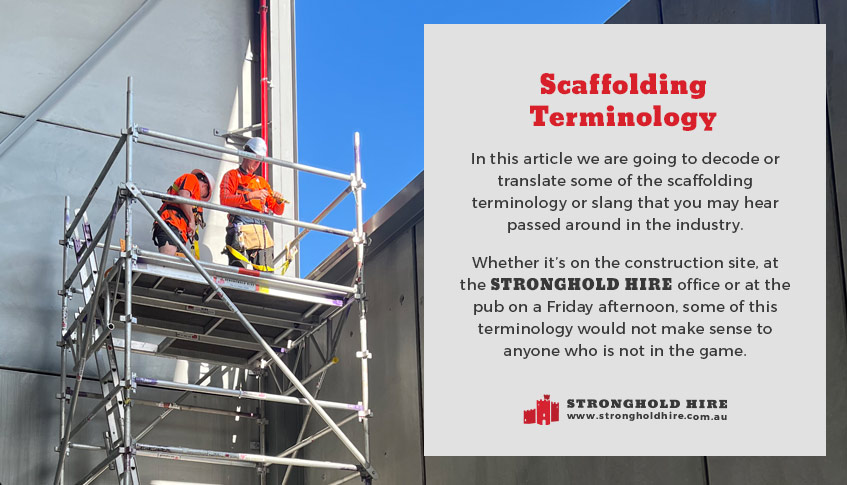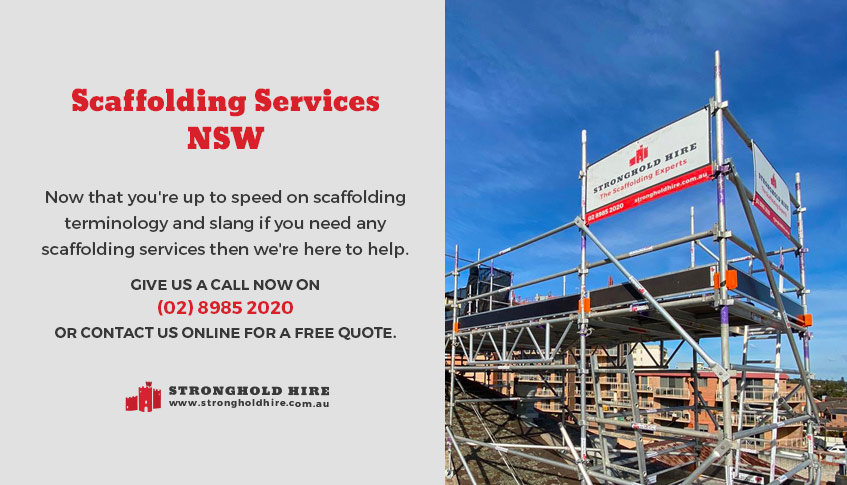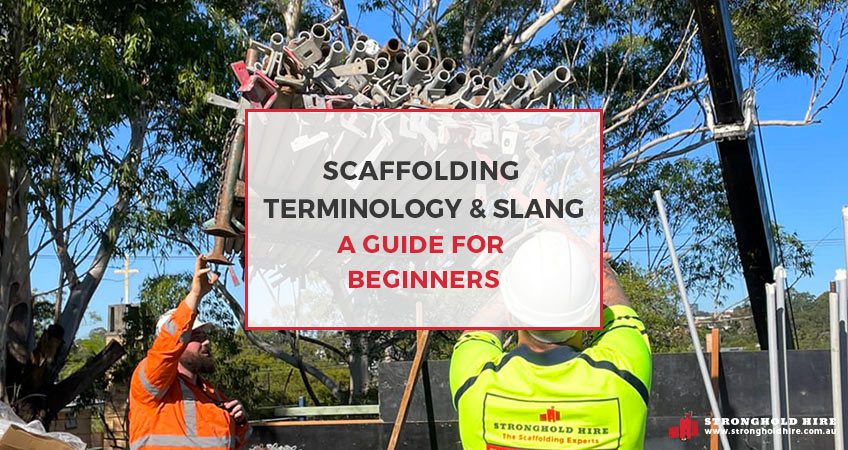In this article we are going to decode or translate some of the scaffolding terminology or slang that you may hear passed around in the industry. Whether it’s on the construction site, at the Stronghold Hire office or at the pub on a Friday afternoon, some of this terminology would not make sense to anyone who is not in the game.

Scaffolding Terminology & Slang
- Scaffold Lift: A scaffold lift refers to a level or platform within a scaffold system that allows workers to access various heights during construction or maintenance work. It is a horizontal platform where workers can stand and perform tasks at different elevations. Scaffold lifts are created by adding horizontal support ledgers and transoms to create multiple levels within the scaffolding system, enabling workers to work comfortably and safely at various heights.
- Raker Tube: A raker tube is a diagonal component in a scaffolding system that provides lateral support and stability to the scaffold structure. It is installed diagonally between the standards (vertical members) and ledgers (horizontal members) to help counteract lateral forces and prevent the scaffold from swaying or collapsing. Raker tubes are essential for ensuring the overall stability and structural integrity of the scaffold, especially when it is erected on uneven or sloping surfaces.
- Buttress Bay/Outrigger: A buttress bay is an additional section or bay of scaffold that is added to the primary scaffolding structure to provide extra support and stability. It is typically installed to reinforce the scaffold against lateral forces or to counteract any instability caused by the external environment. Buttress bays are strategically placed at specific intervals along the length of the scaffold to enhance its overall strength and resistance to external pressures.
- Dummy Lift: A dummy lift refers to a temporary or false section of a scaffold that is inserted between the main working platforms to maintain the required vertical spacing and alignment of the scaffold. It is not intended for use by workers but is included to ensure that the working platforms are evenly spaced and at the appropriate heights. Dummy lifts are commonly used to maintain the structural integrity and stability of the scaffold while providing a uniform and secure platform for workers to perform tasks at different levels.
- Dummy Leg: A dummy leg in scaffolding refers to a vertical member or a support that is attached to the main scaffold structure. It is used to provide additional stability and support to the scaffold, especially when the scaffold needs to be extended beyond its normal reach. Dummy legs are often temporary and are typically removed once the need for additional support is no longer required.
- Cantilever Scaffold: A cantilever scaffold is a type of scaffolding that extends horizontally from a support structure, such as a building or a framework, without any additional support beneath the free end. This type of scaffold is commonly used when it is not possible or practical to erect a scaffold from the ground up. Cantilever scaffolds are designed to provide access to areas that are otherwise difficult to reach, such as the sides of buildings or structures.
- Hung Scaffold: A hung scaffold, also known as a suspended scaffold, is a type of scaffold that is suspended from the top of a structure, usually by ropes, chains, or cables. It is commonly used for tasks such as window washing, exterior painting, or repairs on tall buildings. Hung scaffolds offer the advantage of providing access to the sides of a building without requiring support from the ground, making them suitable for situations where ground-based scaffolding is not feasible.
- Suspended Scaffold: A suspended scaffold is a type of platform that is suspended from the top of a building or structure by ropes, cables, or chains. It allows workers to access and work on various parts of a building’s exterior. Suspended scaffolds are often used for tasks such as building maintenance, window installation, or exterior renovations. They are designed to be adjustable in height and can be easily moved to different locations around the building.
- Dog Leg/End Brace: A dog leg brace is a diagonal brace used in scaffolding to provide additional lateral support and stability. It is typically set at an angle between the vertical standards of the scaffold structure. The dog leg brace helps to prevent lateral movement and swaying of the scaffold, thereby enhancing the overall stability and safety of the scaffold system, especially in taller or larger structures where a normal anchor/tie pattern cannot be achieved.
- Longitudal/Sway/Wing Brace: A wing brace is a type of diagonal brace that extends outward from the main scaffold structure or between two vertical uprights to provide additional lateral support. It is typically positioned Horizontally and attached to the transoms or ledgers of the scaffold. Wing braces are essential for reinforcing the scaffold system, particularly when additional lateral stability is required, such as in situations where the scaffold is subjected to strong winds or other lateral forces and/or tie spacing is larger than standard.
- Box Tie: A box tie is a structural bracing element used in scaffolding to provide lateral support and reinforcement to the scaffold structure. It is created by forming a rectangular or square shape by connecting tubes or pipes in a crisscross manner, thereby creating a box-like structure that helps to stabilize the scaffold against lateral forces. Box ties are commonly used to strengthen the overall integrity of the scaffold, particularly in situations where the scaffold is exposed to external forces that may cause it to sway or shift.
She’ll be alright/Can’t see it outside my house/We are not scaffolding Big Ben
These terms we do not need to explain as we hope that the installers that Stronghold Hire provide would never use these phrases!

Scaffolding Services NSW
Now that you’re up to speed on scaffolding terminology and slang if you need any scaffolding services then we’re here to help. Give us a call now on 02 89852020 or contact us online for a free quote.

